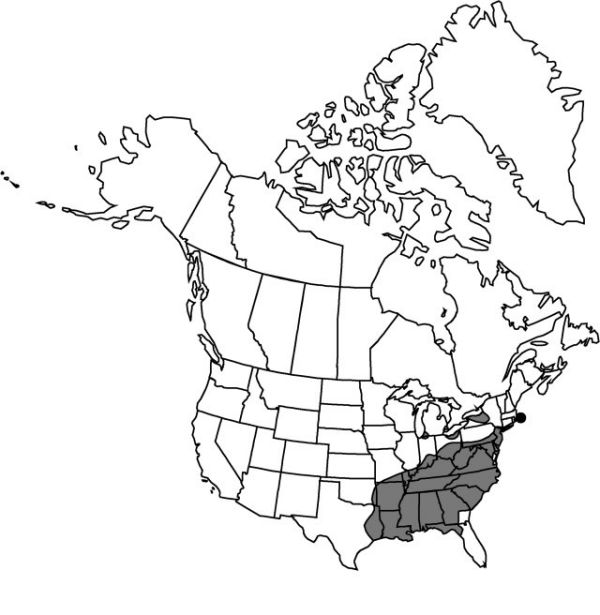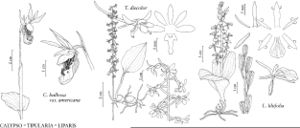Difference between revisions of "Tipularia discolor"
Gen. N. Amer. Pl. 2: 195. 1818.
FNA>Volume Importer |
imported>Volume Importer |
||
| (3 intermediate revisions by 2 users not shown) | |||
| Line 6: | Line 6: | ||
|place=2: 195. 1818 | |place=2: 195. 1818 | ||
|year=1818 | |year=1818 | ||
| + | }} | ||
| + | |special_status={{Treatment/ID/Special_status | ||
| + | |code=F | ||
| + | |label=Illustrated | ||
| + | }}{{Treatment/ID/Special_status | ||
| + | |code=E | ||
| + | |label=Endemic | ||
}} | }} | ||
|basionyms={{Treatment/ID/Basionym | |basionyms={{Treatment/ID/Basionym | ||
|name=Orchis discolor | |name=Orchis discolor | ||
|authority=Pursh | |authority=Pursh | ||
| + | |rank=species | ||
|publication_title=Fl. Amer. Sept. | |publication_title=Fl. Amer. Sept. | ||
|publication_place=2: 586. 1814 | |publication_place=2: 586. 1814 | ||
| Line 16: | Line 24: | ||
|name=Tipularia unifolia | |name=Tipularia unifolia | ||
|authority=(Muhlenberg) Britton, Sterns & Poggenberg | |authority=(Muhlenberg) Britton, Sterns & Poggenberg | ||
| + | |rank=species | ||
}} | }} | ||
|hierarchy=Orchidaceae;Orchidaceae subfam. Epidendroideae;Orchidaceae tribe Calypsoeae;Tipularia;Tipularia discolor | |hierarchy=Orchidaceae;Orchidaceae subfam. Epidendroideae;Orchidaceae tribe Calypsoeae;Tipularia;Tipularia discolor | ||
| Line 40: | Line 49: | ||
-->{{#Taxon: | -->{{#Taxon: | ||
name=Tipularia discolor | name=Tipularia discolor | ||
| − | |||
|authority=(Pursh) Nuttall | |authority=(Pursh) Nuttall | ||
|rank=species | |rank=species | ||
| Line 54: | Line 62: | ||
|publication title=Gen. N. Amer. Pl. | |publication title=Gen. N. Amer. Pl. | ||
|publication year=1818 | |publication year=1818 | ||
| − | |special status= | + | |special status=Illustrated;Endemic |
| − | |source xml=https:// | + | |source xml=https://bitbucket.org/aafc-mbb/fna-data-curation/src/2e0870ddd59836b60bcf96646a41e87ea5a5943a/coarse_grained_fna_xml/V26/V26_1277.xml |
|subfamily=Orchidaceae subfam. Epidendroideae | |subfamily=Orchidaceae subfam. Epidendroideae | ||
|tribe=Orchidaceae tribe Calypsoeae | |tribe=Orchidaceae tribe Calypsoeae | ||
Latest revision as of 21:12, 5 November 2020
Plants 10–65 cm. Corms 7–30(–50) mm diam. Stems scapose, glabrous, basally 1–2-sheathed. Leaves persisting over winter; petioles 3–15 cm; blade purple abaxially, green or greenish purple adaxially, ovate, 5–10.5 × 2.5–7 cm. Inflorescences 8–28 cm; floral bracts 0.2 mm. Flowers green, pale greenish yellow, or greenish purple, (5–)10–55; sepals distinct and free, oblong-elliptic to oblanceolate, 5–8 × 1.5–2.8 mm; petals linear-oblong to oblong-elliptic to linear-oblanceolate, 4–7 × 1–1.8 mm; lip 5–8 × 2.5–3 mm, with 2 prominent basal lobes, spur 10–23 mm; column 2.5–4 mm. Capsules 9–12 × 4–5 mm.
Phenology: Flowering Jun (north)–Sep (south).
Habitat: In humus-rich soil of deciduous woodlands, frequently in sandy, acid oak-pine woods of Southeast, often in depressions under sweet gum
Elevation: 0–1000 m
Distribution

Ala., Ark., Del., Fla., Ga., Ill., Ind., Ky., La., Md., Mass., Mich., Miss., Mo., N.J., N.Y., N.C., Ohio, Okla., Pa., S.C., Tenn., Tex., Va., W.Va.
Discussion
Tipularia discolor is pollinated by noctuid moths, the pollinaria attaching to either the left or right compound eye depending on whether the column of a particular flower is slightly twisted to the left or to the right (W. P. Stoutamire 1978).
Selected References
None.
